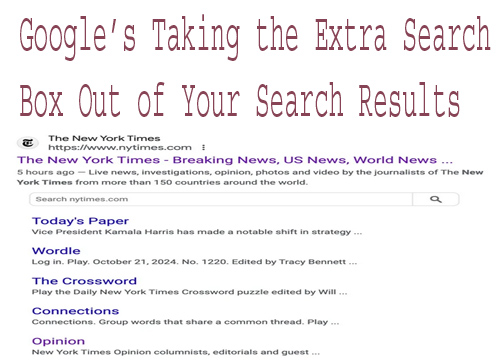Introduction
For years, Google has been quietly helping users refine their searches with an extra feature known as the
Sitelinks Search Box. This small search box appeared beneath search results for certain websites, like The New York Times, allowing users to search within a specific site directly from the search results page. However, starting in November, Google is phasing out this feature globally due to decreased usage.
While many people may not have even noticed its presence, the removal of the Sitelinks Search Box signals a subtle yet meaningful change in the way Google Search is evolving, particularly as the platform leans more into artificial intelligence (AI) and rethinks its approach to delivering information. So, what does this change mean for you, the everyday user or SEO professional? Let’s dive into the details.
What Was the Sitelinks Search Box?
The
Sitelinks Search Box was a convenient tool that appeared beneath certain search results, particularly for well-known or content-heavy websites. This extra search box allowed users to conduct a more targeted search within a specific website without having to visit the website first and use its internal search function. For instance, if you searched for "The New York Times" on Google, you might see an extra search bar just beneath the result, giving you the option to search for content within that site right from the search results page.
It was especially useful for users who wanted to go straight to a specific article or piece of content from large websites with vast archives.
Why Is Google Removing the Feature?
Google has stated that
“usage has dropped” as the primary reason for discontinuing the Sitelinks Search Box. While the feature seemed convenient, many users either weren’t aware of its existence or didn’t find it necessary to use. The rise of more sophisticated search technologies may also have played a role in its decline.
Here are a few reasons that may have contributed to its removal:
- Low Engagement: Despite its potential usefulness, the feature wasn't widely adopted. Many users likely didn’t notice it or simply preferred to navigate directly to a website to use its built-in search function.
- Improved Search Capabilities: Over the years, Google has made significant improvements to its search engine, making it smarter and more capable of delivering relevant results without the need for extra tools. Features like AI-driven search enhancements have made Google more accurate at understanding what users are looking for, even if their queries are somewhat vague or incomplete.
- User Experience Simplification: Google is always experimenting with ways to streamline its user interface. Removing underutilized features like the Sitelinks Search Box allows Google to declutter the search experience and focus on features that provide more value.
- Mobile-Focused Design: With a growing number of users accessing Google Search from mobile devices, simplifying the search interface is crucial. The extra search box could have cluttered the page, especially on smaller screens, making for a less streamlined experience.
How Does This Change Impact You?
For many users, the removal of the Sitelinks Search Box will go unnoticed. If you’re someone who rarely used the feature, this change won’t affect your search habits much. However, for those who regularly relied on it to dive deeper into a specific website’s content, the adjustment could require some adaptation.
Here’s what the impact may look like:
- Direct Navigation: Instead of using the search box within Google results, users will need to navigate directly to the website they want to search within. For example, to search for specific articles within The New York Times, you’ll now have to visit the site and use its internal search function.
- More Emphasis on Google’s Search Algorithms: Google’s advancements in AI mean that users can now perform more complex and nuanced searches without needing to specify a site. For instance, if you’re looking for a specific article on The New York Times, a well-crafted query on Google will likely still surface what you’re seeking.
- SEO Implications: From an SEO perspective, the removal of the Sitelinks Search Box might impact the way certain sites appear in search results. Websites that benefited from users using the search box for more targeted queries may see slight changes in how their traffic behaves.
Google's Shift Toward AI in Search
The removal of the Sitelinks Search Box is just one of many changes Google has been implementing in recent years as it leans further into artificial intelligence to improve search results. Google’s AI-driven updates, like
BERT (Bidirectional Encoder Representations from Transformers) and
MUM (Multitask Unified Model), have made the search engine better at understanding context and delivering more accurate results. These changes reduce the need for extra tools like the Sitelinks Search Box.
In essence, Google wants to deliver answers quickly and accurately without requiring users to take extra steps. By focusing on AI, the search engine is becoming more intuitive, capable of interpreting complex queries, and delivering answers even when the search terms are ambiguous.
Conclusion
Google’s decision to remove the extra Sitelinks Search Box is a subtle change that reflects a broader shift in the way search engines function. While the feature offered convenience for some users, its low usage and the rise of AI-enhanced search capabilities have made it less necessary. Most users won’t notice its absence, and those who do will likely find Google’s other search features more than adequate replacements.
As Google continues to evolve, we can expect more changes like this as it refines its user interface and makes the search process faster, more intuitive, and more responsive to user needs. Whether you’re an everyday Google user or an SEO professional, this is another step in Google’s ongoing journey to make information more accessible with minimal friction.

